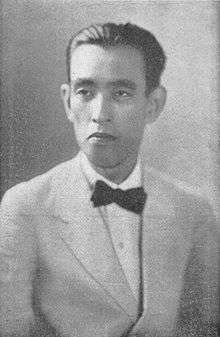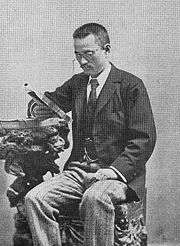Kafū Nagai
| Kafū Nagai | |
|---|---|
 Kafū Nagai in 1927 | |
| Born |
Nagai Sōkichi December 3, 1879 Tokyo, Japan |
| Died |
April 30, 1959 (aged 79) Ichikawa, Japan |
| Occupation | Author, translator |
| Nationality | Japanese |
| Subject | French literature, Japanese-Edo literature |
| Literary movement | Aestheticism |

Kafū Nagai (永井 荷風 Nagai Kafū, 3 December 1879 – 30 April 1959) was the pseudonym of the Japanese author, playwright, essayist, and diarist Nagai Sōkichi (永井 壮吉). His works are noted for their depictions of life in early 20th-century Tokyo, especially among geisha, prostitutes, cabaret dancers, and other denizens of the city's lively entertainment districts.
Biography
Kafū was born at Kanetomi-chō 45, Koishikawa-ku (now Kasuga-chō, Bunkyō, Tokyo), the eldest son of Nagai Kyūichirō (永井 久一郎), his father, who was 28 years old, and Nagai Tsune (永井 恆), 19. Kyūichirō was a scholar, bureaucrat, and businessman who later became known for his Chinese poetry. Kafū had three brothers and one sister. When the second son was born in 1883, Kafū was sent to live with his mother's family. In 1884, he attended the kindergarten affiliated with the Ochanomizu women's teachers' college, and his father visited Europe on government business. Kafū returned to his parents' home in January 1886, when he started elementary school.
In 1891, he attended a private English-language school in Kanda, Tokyo. In 1894, he became ill, perhaps with scrofula, and spent several months in 1895 in a hospital in Odawara. He began studying the shakuhachi and Chinese poetry in 1896 at the age of 17. In February of the following year, he made his first of many visits to the Yoshiwara red-light district. The same year, he graduated from middle school and failed the entrance exam for university. With his mother and younger brothers, he visited Shanghai, where his father was working for the shipping company Nippon Yusen. He returned to Japan in the autumn and enrolled in the Chinese-language department of the institutions for foreign-language educations affiliated with the Higher Commercial School.
In 1898, he began writing short stories and studied with the novelist Hirotsu Ryūrō (広津 柳浪). In 1899 he became involved in writing and performing rakugo and dropped out of the foreign-language school. In 1900, he began publishing short stories. In 1901, he got a job briefly as a newspaper reporter and later began studying French.
The following timeline is based on notes that he appended to the 11th handwritten volume of Danchōtei Nichijō:
- 1903: Travels to the United States. Stays in Tacoma, Washington.
- 1904: Visits the St. Louis Exposition. Enrolls in Kalamazoo College in Michigan.
- 1905: Moves to New York City and begins working for a Japanese bank.
- 1906: Travels to Lyon, Paris, and London, and then returns to Japan. Publishes American Stories in 1908 (with three French travel stories, deleted from later editions).[1]
- 1907: Publishes Furansu Monogatari (French Stories), which is immediately suppressed.
- 1908–11: Has many stories published and some plays performed. Studies at Kalamazoo College, in Michigan.
- 1912: Marries.
- 1913: Father dies. Publishes collection of translated poems. Gets divorced. Takes on a mistress.
- 1914: Marries again.
- 1915: Anthology of works published. Divorces again. Lives for several months in a geisha house.
- 1916: Launches a literary magazine.
- 1918: First volume of collected works published.
- 1919: Second and third volumes of collected works published. Takes on a mistress.
- 1920: Play performed at Imperial Theater. Lets mistress go.
- 1921–22: Several plays performed in Tokyo.
- 1923–44: Continues to write, though publications become less frequent.
- 1945: Tokyo home destroyed in air raids. Moves to apartment, which is also destroyed.
During World War II, the amount of Japanese literature published was limited due to extreme censorship by the government, which sought to encourage artists and writers to direct their focus toward the war effort. Nagai Kafu became one of the rebels who opposed the government and continued to write. As a result, he was able to maintain his status as a popular novelist throughout the war. After the war, many Japanese authors were emotionally and psychologically affected, and the aftereffects began to show in narratives, poems and essays related to death, disease, despair and defeat. However, since Nagai Kafu did not contribute to the war effort, he was not influenced as heavily by the defeat and continued to write about the things he loved in life, notably geisha, prostitutes and dancers, until his death, on April 30, 1959, from a gastric ulcer.
The edition of his collected works published by Iwanami Shoten in the 1990s runs to 30 volumes.
Writing style
Nagai's writing style varied depending on his genre and audience. Reflecting his study of classical Chinese and his wide reading of premodern Japanese texts, his diaries and some of his essays are written in the highly literary bungo (文語) style. Most of his plays and novels, in contrast, are written in a modern style typical of the era in which he wrote, and the dialogue spoken by his characters seems particularly natural and unaffected.
Major works
Among Nagai's major works are:
- American Stories (あめりか物語, Amerika Monogatari, 1908; modern English ed., Columbia University Press, 2000).
- Geisha in Rivalry (腕くらべ, Ude Kurabe, 1916-1917)
- A Strange Tale from East of the River (濹東綺譚, Bokutō Kidan, 1937)
- His diaries, especially Danchōtei Nichijō (断腸亭日乗, written 1917-1959)
- During the Rains & Flowers in the Shade
- Sumida River (すみだ川, Sumidagawa, 1911)
See also
References
- ↑ As reported in the 2000 English edition by Mitsuko Iriye (American Stories, Columbia University Press, p. xxv)
External links
| Wikimedia Commons has media related to Kafū Nagai. |
- Works by Kafu Nagai at Project Gutenberg
- Works by or about Kafū Nagai at Internet Archive
- Works by Kafū Nagai at LibriVox (public domain audiobooks)

- J'Lit | Authors : Kafu Nagai | Books from Japan (English)
- Kafū Nagai's grave (English)